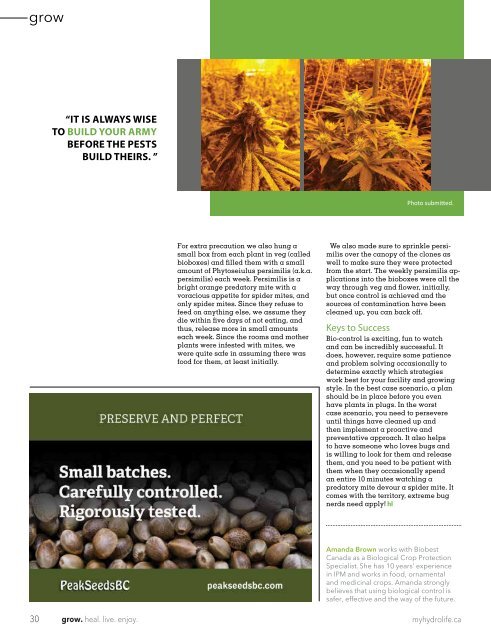Hydrolife Magazine August/September 2016 (Canadian Edition)
Welcome to the third edition of thenew Hydrolife. At this point, all we can say is “wow”. The response from readers, industry professionals and those who use cannabis to heal themselves has blown away all expectations. When we started Hydrolife with a medicinal cannabis theme, our intent was to connect growers, medical practitioners, patients and health enthusiasts by providing information related to this powerful plant. As we continue to do that, it is becoming apparent that passion in the medicinal cannabis revolution runs deep.
Welcome to the third edition of thenew Hydrolife. At this point, all we can say is “wow”. The response from readers, industry professionals and those who use cannabis to heal themselves has blown away all expectations. When we started Hydrolife with a medicinal cannabis theme, our intent was to connect growers,
medical practitioners, patients and health enthusiasts by providing information
related to this powerful plant. As we continue to do that, it is becoming apparent
that passion in the medicinal cannabis revolution runs deep.
You also want an ePaper? Increase the reach of your titles
YUMPU automatically turns print PDFs into web optimized ePapers that Google loves.
grow<br />
“IT IS ALWAYS WISE<br />
TO BUILD YOUR ARMY<br />
BEFORE THE PESTS<br />
BUILD THEIRS. ”<br />
Photo submitted.<br />
For extra precaution we also hung a<br />
small box from each plant in veg (called<br />
bioboxes) and filled them with a small<br />
amount of Phytoseiulus persimilis (a.k.a.<br />
persimilis) each week. Persimilis is a<br />
bright orange predatory mite with a<br />
voracious appetite for spider mites, and<br />
only spider mites. Since they refuse to<br />
feed on anything else, we assume they<br />
die within five days of not eating, and<br />
thus, release more in small amounts<br />
each week. Since the rooms and mother<br />
plants were infested with mites, we<br />
were quite safe in assuming there was<br />
food for them, at least initially.<br />
We also made sure to sprinkle persimilis<br />
over the canopy of the clones as<br />
well to make sure they were protected<br />
from the start. The weekly persimilis applications<br />
into the bioboxes were all the<br />
way through veg and flower, initially,<br />
but once control is achieved and the<br />
sources of contamination have been<br />
cleaned up, you can back off.<br />
Keys to Success<br />
Bio-control is exciting, fun to watch<br />
and can be incredibly successful. It<br />
does, however, require some patience<br />
and problem solving occasionally to<br />
determine exactly which strategies<br />
work best for your facility and growing<br />
style. In the best case scenario, a plan<br />
should be in place before you even<br />
have plants in plugs. In the worst<br />
case scenario, you need to persevere<br />
until things have cleaned up and<br />
then implement a proactive and<br />
preventative approach. It also helps<br />
to have someone who loves bugs and<br />
is willing to look for them and release<br />
them, and you need to be patient with<br />
them when they occasionally spend<br />
an entire 10 minutes watching a<br />
predatory mite devour a spider mite. It<br />
comes with the territory, extreme bug<br />
nerds need apply!<br />
30<br />
grow. heal. live. enjoy.<br />
Amanda Brown works with Biobest<br />
Canada as a Biological Crop Protection<br />
Specialist. She has 10 years’ experience<br />
in IPM and works in food, ornamental<br />
and medicinal crops. Amanda strongly<br />
believes that using biological control is<br />
safer, effective and the way of the future.<br />
myhydrolife.ca




![Hydrolife Magazine December 2017/January 2018 [CANADIAN EDITION]](https://img.yumpu.com/59790088/1/190x247/hydrolife-magazine-december-2017-january-2018-canadian-edition.jpg?quality=85)
![Hydrolife Magazine December 2017/January 2018 [USA EDITION]](https://img.yumpu.com/59790042/1/190x247/hydrolife-magazine-december-2017-january-2018-usa-edition.jpg?quality=85)
![Hydrolife Magazine October/November 2017 [Canada Edition]](https://img.yumpu.com/59493562/1/190x247/hydrolife-magazine-october-november-2017-canada-edition.jpg?quality=85)
![Hydrolife Magazine October/November 2017 [USA Edition]](https://img.yumpu.com/59493548/1/190x247/hydrolife-magazine-october-november-2017-usa-edition.jpg?quality=85)
![Hydrolife Magazine August/September 2017 [USA Edition]](https://img.yumpu.com/59236656/1/190x247/hydrolife-magazine-august-september-2017-usa-edition.jpg?quality=85)









